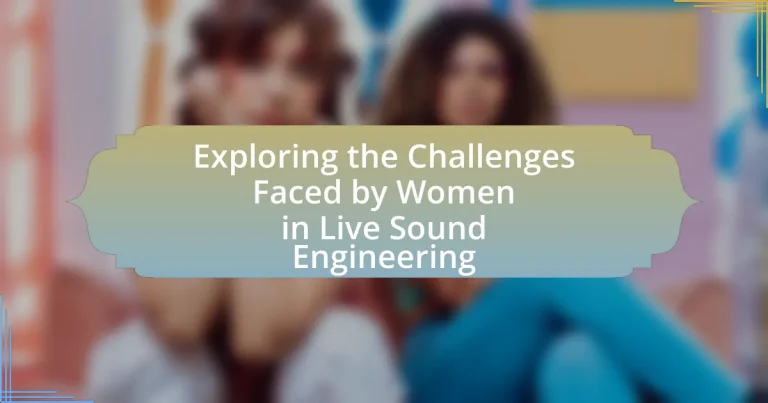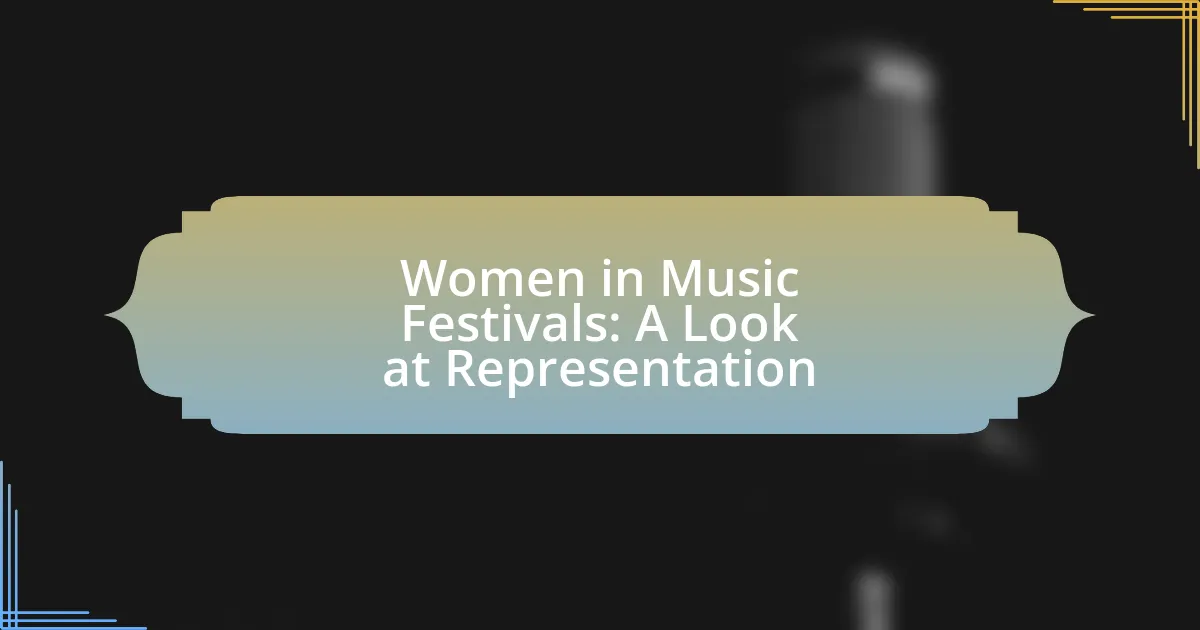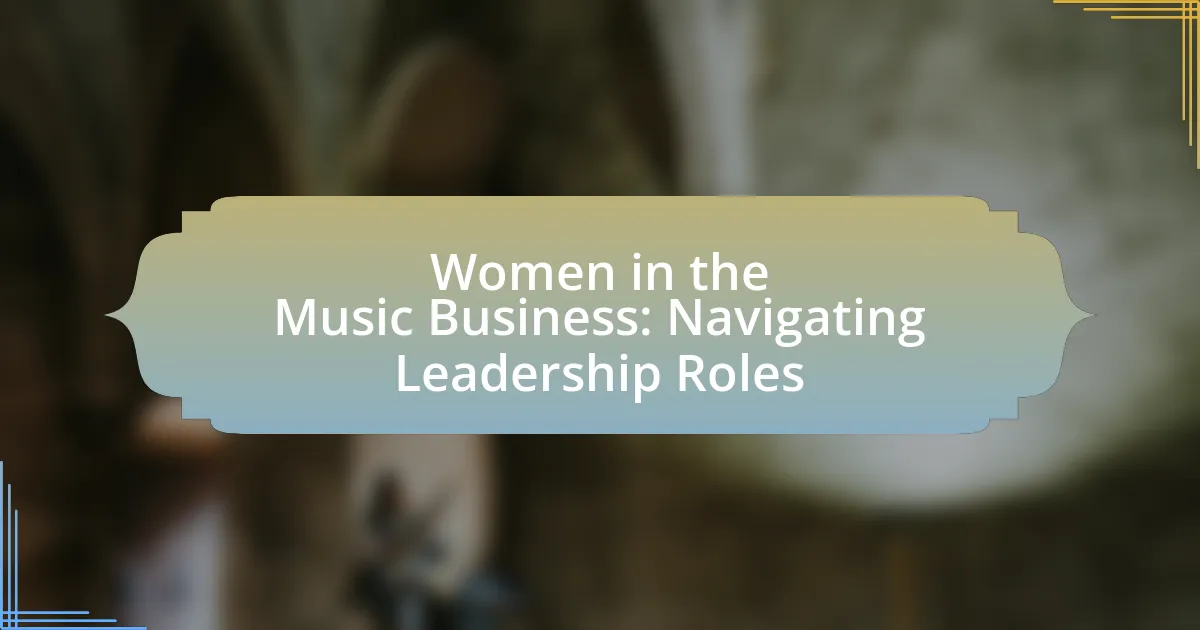The article examines the challenges faced by women in live sound engineering, highlighting issues such as gender bias, lack of representation, and limited access to mentorship opportunities. It discusses how societal perceptions and stereotypes about women’s technical abilities contribute to their underrepresentation in the field, where they comprise only about 5% of audio engineers. Additionally, the article explores the impact of workplace culture on women’s job satisfaction and career choices, as well as initiatives aimed at promoting inclusivity and support for women in technical roles. Strategies for overcoming these challenges, including networking, mentorship, and skill development, are also addressed, along with the evolving landscape of the industry that increasingly recognizes the importance of gender diversity.
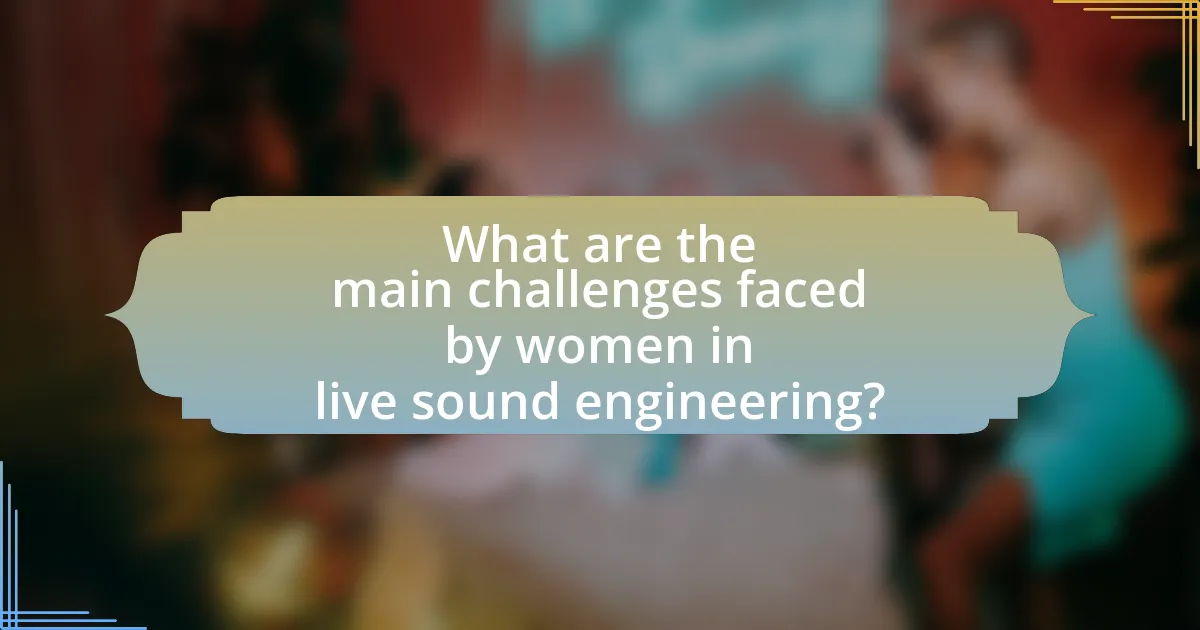
What are the main challenges faced by women in live sound engineering?
The main challenges faced by women in live sound engineering include gender bias, lack of representation, and limited access to mentorship opportunities. Gender bias manifests in the form of stereotypes that question women’s technical abilities, often leading to exclusion from key roles in sound engineering. The industry is predominantly male, with women making up only about 5% of audio engineers, which contributes to a lack of role models and networking opportunities. Additionally, women often encounter difficulties in finding mentors who can provide guidance and support, further hindering their professional growth in a field where connections are crucial for career advancement.
How do societal perceptions impact women’s roles in live sound engineering?
Societal perceptions significantly limit women’s roles in live sound engineering by perpetuating stereotypes that associate technical skills with masculinity. This bias leads to underrepresentation of women in the field; for instance, a 2020 report by the Audio Engineering Society found that women make up only about 5% of audio engineers. Such perceptions discourage women from pursuing careers in this area, as they may feel unwelcome or unsupported in a male-dominated environment. Additionally, these societal views can influence hiring practices, often favoring male candidates over equally qualified female candidates, further entrenching gender disparities in the industry.
What stereotypes exist regarding women in technical fields?
Stereotypes regarding women in technical fields include the belief that women lack the necessary technical skills and aptitude for roles in engineering and technology. This stereotype is often reinforced by the underrepresentation of women in these fields, with only about 28% of the workforce in STEM (Science, Technology, Engineering, and Mathematics) being female, according to the National Science Foundation. Additionally, women are frequently perceived as less committed or serious about their careers in technical domains, which can lead to biases in hiring and promotion practices. These stereotypes contribute to a challenging environment for women pursuing careers in technical fields, including live sound engineering.
How do these perceptions affect women’s career choices in live sound engineering?
Perceptions of gender roles and stereotypes significantly affect women’s career choices in live sound engineering by creating barriers to entry and limiting opportunities. Women often face the belief that technical roles are predominantly male, which can discourage them from pursuing careers in this field. Research indicates that only 5% of audio engineers are women, highlighting the impact of these perceptions on their participation. Additionally, the lack of female role models and mentors in live sound engineering further perpetuates the cycle, as women may feel isolated or unsupported in their career aspirations. This environment can lead to lower confidence levels among women, ultimately influencing their decision to enter or remain in the industry.
What barriers do women encounter in the live sound engineering industry?
Women encounter several barriers in the live sound engineering industry, including gender bias, lack of representation, and limited access to mentorship opportunities. Gender bias manifests in the form of stereotypes that question women’s technical abilities, often leading to exclusion from key roles in live sound events. The lack of representation is evident, as women make up only a small percentage of the workforce in this field, which can create an unwelcoming environment. Additionally, limited access to mentorship and networking opportunities hinders women’s professional growth, as they may not have the same connections or support systems as their male counterparts. These barriers collectively contribute to the challenges women face in achieving equality and recognition in the live sound engineering industry.
How does gender bias manifest in hiring practices?
Gender bias manifests in hiring practices through the preference for male candidates over equally qualified female candidates, often based on stereotypes about gender roles. Research indicates that resumes with male names receive more favorable evaluations than those with female names, even when qualifications are identical. A study published in the Proceedings of the National Academy of Sciences found that both male and female evaluators rated male applicants as more competent and hireable than female applicants, highlighting the pervasive nature of this bias in recruitment processes.
What challenges do women face in gaining access to training and mentorship?
Women face significant challenges in gaining access to training and mentorship in live sound engineering due to systemic barriers, lack of representation, and limited networking opportunities. Research indicates that women are often underrepresented in technical fields, which can lead to fewer role models and mentors available for guidance. A study by the Audio Engineering Society found that only 5% of audio engineers are women, highlighting the gender disparity in the industry. Additionally, women may encounter biases that discourage them from pursuing technical training, as well as a lack of supportive environments in educational settings. These factors collectively hinder women’s access to essential training and mentorship opportunities in live sound engineering.
What role does workplace culture play in the experiences of women in live sound engineering?
Workplace culture significantly influences the experiences of women in live sound engineering by shaping their professional interactions, opportunities for advancement, and overall job satisfaction. A supportive workplace culture fosters inclusivity, encourages collaboration, and provides mentorship, which can enhance women’s confidence and performance in a predominantly male-dominated field. Conversely, a toxic or exclusionary culture can lead to feelings of isolation, discrimination, and hinder career progression. Research indicates that organizations with positive workplace cultures report higher retention rates of women in technical roles, highlighting the importance of cultural dynamics in shaping their experiences and success in live sound engineering.
How do male-dominated environments affect women’s job satisfaction?
Male-dominated environments negatively affect women’s job satisfaction by creating barriers to inclusion and support. Research indicates that women in such settings often experience feelings of isolation, lack of mentorship, and limited opportunities for advancement, which contribute to lower job satisfaction levels. A study published in the Journal of Applied Psychology found that women in male-dominated fields reported higher levels of job dissatisfaction due to perceived discrimination and a lack of recognition for their contributions. This context highlights the challenges women face in achieving equitable job satisfaction in environments where they are underrepresented.
What initiatives exist to promote inclusivity in live sound engineering workplaces?
Initiatives promoting inclusivity in live sound engineering workplaces include mentorship programs, diversity training, and industry partnerships aimed at increasing representation. Organizations like Women in Audio and SoundGirls provide resources and networking opportunities specifically for women in the field, fostering a supportive community. Additionally, companies are increasingly implementing diversity hiring practices and creating inclusive workplace policies to ensure a more equitable environment. Research indicates that diverse teams lead to improved creativity and problem-solving, reinforcing the importance of these initiatives in enhancing workplace dynamics.
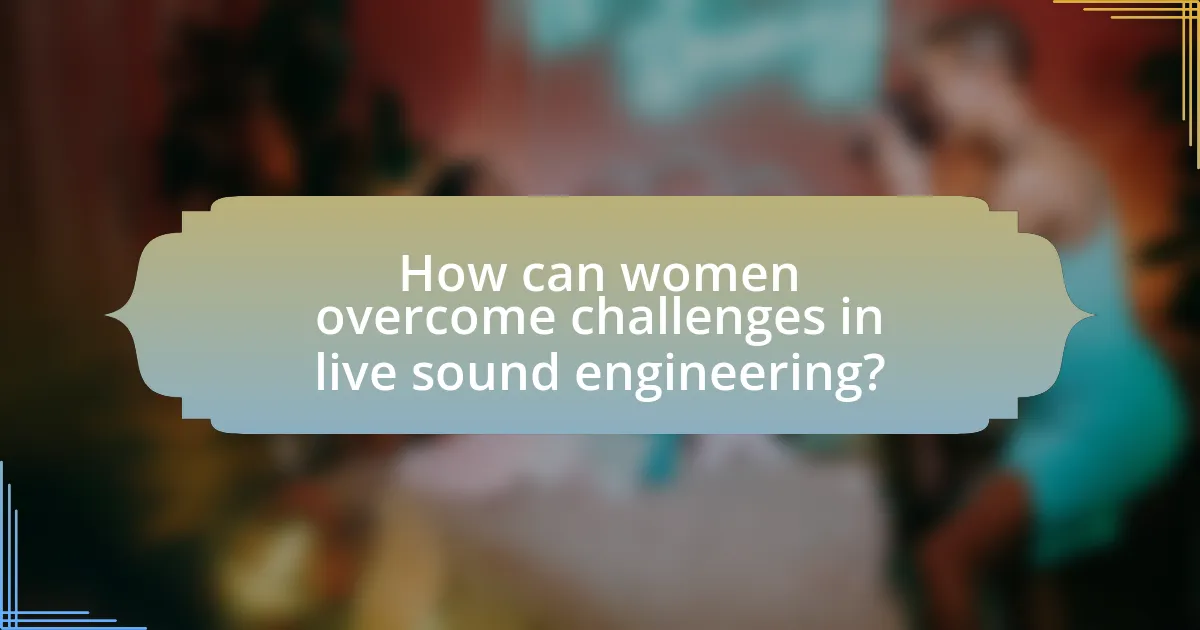
How can women overcome challenges in live sound engineering?
Women can overcome challenges in live sound engineering by actively seeking mentorship and networking opportunities within the industry. Establishing connections with experienced professionals can provide guidance, support, and access to resources that are crucial for skill development. Research indicates that mentorship significantly enhances career advancement, particularly for women in male-dominated fields, as noted in a study published by the American Psychological Association, which found that women with mentors are more likely to achieve leadership roles. Additionally, participating in workshops and training programs specifically designed for women can help build confidence and technical skills, further empowering them to navigate and succeed in the live sound engineering landscape.
What strategies can women employ to navigate gender bias in the industry?
Women can navigate gender bias in the industry by actively seeking mentorship, building strong professional networks, and advocating for themselves in the workplace. Mentorship provides guidance and support, helping women to develop skills and confidence; studies show that women with mentors are more likely to advance in their careers. Building professional networks allows women to connect with allies and advocates who can provide opportunities and resources, as research indicates that networking is crucial for career advancement. Additionally, self-advocacy empowers women to articulate their contributions and negotiate for fair treatment, which is essential in combating bias, as data from the Lean In and McKinsey report highlights that women often face barriers in promotion and pay negotiations.
How can networking and mentorship support women’s careers in live sound engineering?
Networking and mentorship can significantly enhance women’s careers in live sound engineering by providing access to industry connections and guidance from experienced professionals. These relationships facilitate opportunities for skill development, job placements, and collaboration on projects, which are crucial in a field where women are underrepresented. For instance, a study by the Women’s Audio Mission found that mentorship programs can increase women’s confidence and technical skills, leading to higher retention rates in audio engineering roles. Additionally, networking events create platforms for women to share experiences and resources, fostering a supportive community that can combat the isolation often felt in male-dominated environments.
What skills should women focus on developing to enhance their opportunities?
Women should focus on developing technical skills, communication skills, and networking abilities to enhance their opportunities in live sound engineering. Technical skills, such as proficiency in audio equipment and software, are essential for effective sound management and production. Communication skills enable women to articulate their ideas clearly and collaborate with diverse teams, which is crucial in a collaborative field like sound engineering. Networking abilities help women build professional relationships and access mentorship opportunities, which can lead to career advancement. According to a study by the Audio Engineering Society, women who actively engage in networking and skill development are more likely to secure positions in technical roles within the industry.
What resources are available for women pursuing careers in live sound engineering?
Women pursuing careers in live sound engineering can access various resources, including mentorship programs, professional organizations, and educational opportunities. Organizations such as Women in Audio and the Audio Engineering Society provide networking, training, and support specifically tailored for women in the industry. Additionally, workshops and courses offered by institutions like Berklee College of Music and online platforms like Coursera focus on sound engineering skills, enhancing women’s technical expertise. These resources are essential for addressing the gender gap in the field and empowering women to succeed in live sound engineering careers.
Which organizations support women in technical roles?
Organizations that support women in technical roles include Women Who Code, Girls Who Code, and the Society of Women Engineers. Women Who Code focuses on empowering women in technology through networking, mentorship, and skill development. Girls Who Code aims to close the gender gap in technology by providing educational resources and programs for young girls. The Society of Women Engineers offers professional development, networking opportunities, and advocacy for women in engineering fields. These organizations collectively contribute to increasing the representation and support of women in technical roles.
What educational programs are tailored for women in sound engineering?
Educational programs tailored for women in sound engineering include initiatives like the Women’s Audio Mission, which offers training and mentorship specifically for women in audio and sound technology. Additionally, institutions such as Berklee College of Music and SAE Institute provide scholarships and workshops aimed at increasing female participation in sound engineering. These programs are designed to address the gender gap in the industry by providing women with the skills and confidence needed to succeed in sound engineering roles.
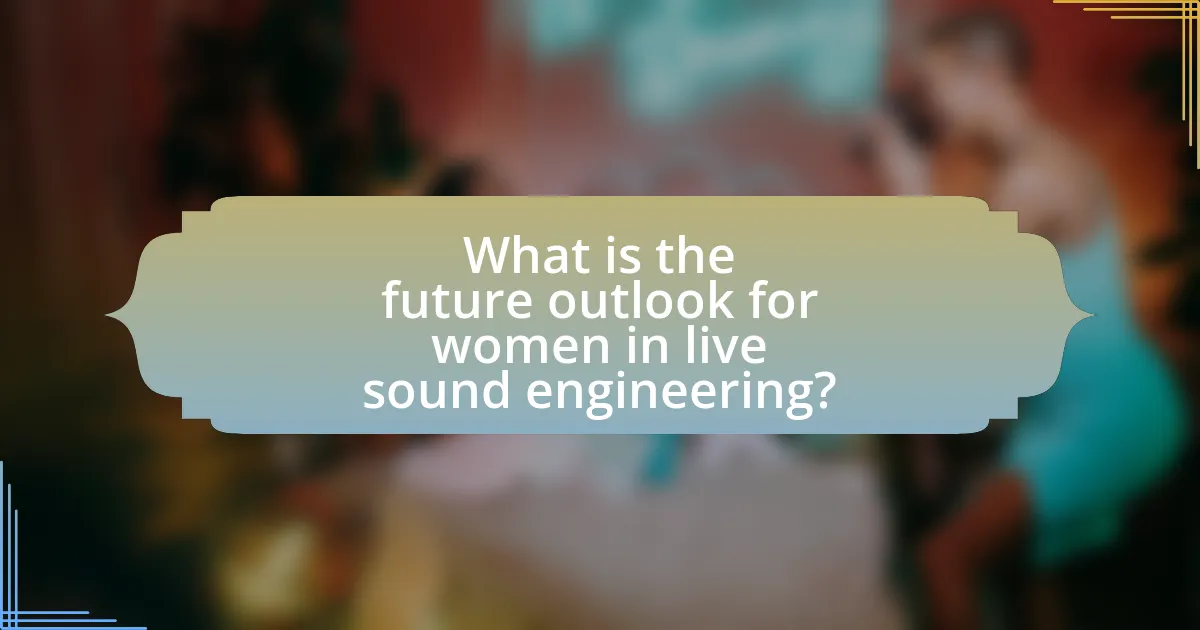
What is the future outlook for women in live sound engineering?
The future outlook for women in live sound engineering is increasingly positive, driven by a growing recognition of gender diversity’s importance in the industry. Initiatives aimed at promoting inclusivity, such as mentorship programs and workshops specifically for women, are gaining traction, leading to more women entering the field. According to a 2021 report by the Audio Engineering Society, women represent approximately 20% of the audio engineering workforce, a figure that is gradually increasing as educational institutions and industry organizations actively encourage female participation. This trend indicates a shift towards a more balanced representation, suggesting that the future will likely see a significant rise in the number of women in live sound engineering roles.
How is the industry evolving to support women in technical roles?
The industry is evolving to support women in technical roles through initiatives such as mentorship programs, diversity hiring practices, and targeted training opportunities. Companies are increasingly recognizing the importance of gender diversity in technical fields, leading to the implementation of policies that promote inclusive work environments. For instance, organizations like Women in Audio and the Audio Engineering Society have launched programs specifically designed to empower women in sound engineering, providing resources and networking opportunities. Additionally, statistics show that companies with diverse teams are 35% more likely to outperform their competitors, highlighting the business case for supporting women in technical roles.
What trends indicate a shift towards greater gender equality in live sound engineering?
Trends indicating a shift towards greater gender equality in live sound engineering include an increase in female representation in technical roles, the establishment of mentorship programs, and the rise of organizations advocating for women in audio. The percentage of women in live sound roles has grown from approximately 5% to around 20% in recent years, reflecting a broader acceptance and encouragement of female professionals in the industry. Additionally, initiatives like the Women’s Audio Mission and the SoundGirls organization provide resources and networking opportunities, fostering a supportive community that empowers women to pursue careers in sound engineering. These trends collectively demonstrate a positive movement towards inclusivity and equality in a historically male-dominated field.
How can emerging technologies create new opportunities for women in the field?
Emerging technologies can create new opportunities for women in live sound engineering by providing access to advanced tools and platforms that enhance skills and promote inclusivity. For instance, software like digital audio workstations (DAWs) and remote collaboration tools enable women to participate in projects from anywhere, reducing geographical barriers. Additionally, initiatives such as online training programs and mentorship platforms specifically targeting women in audio engineering are on the rise, fostering a supportive community and skill development. According to a report by the Audio Engineering Society, women represent only 5% of the audio engineering workforce, highlighting the need for targeted technological interventions to increase representation and opportunities in the field.
What best practices can organizations adopt to foster diversity in live sound engineering?
Organizations can foster diversity in live sound engineering by implementing targeted recruitment strategies that prioritize underrepresented groups. For instance, actively seeking candidates from diverse backgrounds through partnerships with educational institutions and community organizations can increase representation. Additionally, providing mentorship programs specifically for women and minorities in the field can enhance skill development and career advancement opportunities. Research indicates that diverse teams lead to more innovative solutions and improved performance, as evidenced by a McKinsey report showing that companies in the top quartile for gender diversity are 21% more likely to outperform their peers in profitability. Furthermore, creating an inclusive workplace culture that values diverse perspectives and experiences can help retain talent and promote collaboration.
How can companies implement effective diversity training programs?
Companies can implement effective diversity training programs by conducting thorough needs assessments to identify specific diversity challenges within their workforce. This approach ensures that the training is tailored to address the unique issues faced by employees, particularly women in live sound engineering, who often encounter systemic barriers. Research indicates that organizations that customize their training based on employee feedback and demographic data see a 30% increase in engagement and retention of diverse talent. Additionally, incorporating interactive elements, such as workshops and role-playing scenarios, can enhance understanding and empathy among participants, leading to more meaningful discussions about diversity. Regular evaluations of the training’s impact, through surveys and performance metrics, further validate its effectiveness and allow for continuous improvement.
What role do industry leaders play in promoting gender equality in sound engineering?
Industry leaders play a crucial role in promoting gender equality in sound engineering by implementing policies and initiatives that foster inclusivity and support for women in the field. They can influence hiring practices, ensuring diverse candidate pools, and creating mentorship programs that empower women to advance their careers. For instance, organizations like Women in Music and the Audio Engineering Society have established initiatives aimed at increasing female representation in technical roles, demonstrating the effectiveness of leadership commitment to gender equality. Furthermore, industry leaders can advocate for equal pay and create safe work environments, which are essential for retaining female talent in sound engineering.
What practical tips can women follow to succeed in live sound engineering?
Women can succeed in live sound engineering by actively seeking mentorship, gaining hands-on experience, and continuously improving technical skills. Mentorship provides guidance and networking opportunities, which are crucial in a male-dominated field. Gaining hands-on experience through internships or volunteer positions allows women to develop practical skills and confidence. Continuous improvement of technical skills, such as learning about sound equipment and software, is essential for staying competitive. According to a study by the Women’s Audio Mission, women who engage in these practices are more likely to advance in audio engineering careers, highlighting the effectiveness of these strategies.
